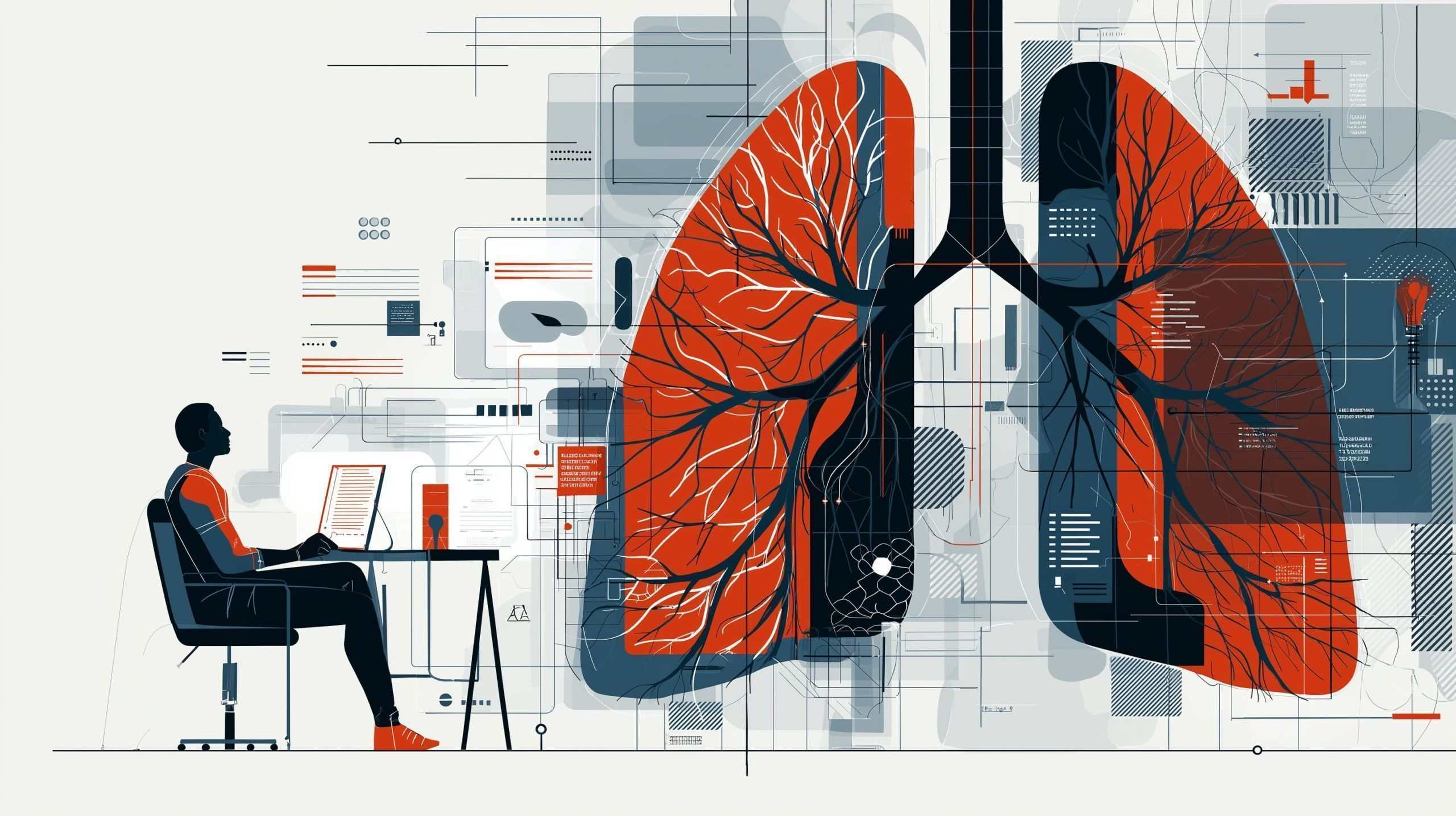- In April 2025, Roche’s Ventana TROP2 (EPR20043) RxDx test became the first AI-powered diagnostic to receive FDA Breakthrough Device Designation.
- The device pairs an immunohistochemistry stain for TROP2 with a digital pathology AI algorithm that runs in Roche’s Navify system to analyze NSCLC biopsy slides.
- The AI calculates a Normalized Membrane Ratio (NMR), the ratio of surface TROP2 to internal TROP2, to classify tumors as TROP2-positive or -negative.
- The Ventana TROP2 RxDx is a full diagnostic system, including Roche’s slide scanners, the Navify image management software, the Ventana TROP2 IHC kit, and the AI algorithm.
- A positive NMR score thresholds the tumor as TROP2-positive, yielding a quantitative score to guide treatment decisions.
- The test serves as a companion diagnostic to Datopotamab deruxtecan (Datroway, Dato-DXd) from Daiichi Sankyo and AstraZeneca for advanced non-squamous NSCLC lacking actionable mutations.
- Datopotamab deruxtecan earned FDA approval in January 2025 for a breast cancer indication and is being evaluated in NSCLC trials.
- In the TROPION-Lung01 Phase III trial, Dato-DXd improved progression-free survival in non-squamous NSCLC but did not significantly prolong overall survival in the broad population.
- A retrospective analysis found that AI-selected TROP2-positive patients had a 43% lower risk of progression or death with Dato-DXd versus chemotherapy, while TROP2-negative patients did not benefit.
- The Breakthrough designation highlights a regulatory shift toward algorithmic companion diagnostics, enabling multi-factor AI biomarkers and faster paths to personalized cancer care.
The First AI-Driven Diagnostic to Earn FDA ‘Breakthrough’ Status
In a milestone for artificial intelligence in medicine, Roche’s VENTANA TROP2 (EPR20043) RxDx test has become the first AI-powered diagnostic to receive the FDA’s coveted Breakthrough Device Designation Roche Clpmag. This computational pathology companion diagnostic – essentially a software-driven analysis of cancer biopsy images – gained the special status in April 2025 for its potential to radically improve treatment selection in non–small cell lung cancer (NSCLC) Roche Curetoday. The FDA’s designation signals that regulators see this tool as a game-changer for patients with advanced lung cancer, and it will fast-track the test’s review and availability in clinical practice Curetoday Openaccessgovernment.
Why it matters: Breakthrough Device Designation is reserved for technologies addressing life-threatening conditions with unmet needs, offering a pathway for accelerated FDA guidance and review Curetoday. Roche’s AI-driven test earned this by demonstrating unprecedented diagnostic precision that could personalize therapy decisions for lung cancer patients Roche Openaccessgovernment. It marks a regulatory first: never before has a pathology algorithm integrated with a lab test received this status, setting a precedent for how AI can be incorporated into diagnostics Roche Clpmag. “This FDA Breakthrough Device Designation is another example of our commitment to deliver innovation that enables more precise diagnosis in oncology,” said Matt Sause, CEO of Roche Diagnostics Roche. Regulators’ endorsement of such AI tools suggests a growing confidence that machine learning can improve patient outcomes in ways traditional methods cannot, an important validation for the field of digital pathology.
Inside Roche’s AI-Powered Lung Cancer Test
Dubbed the Ventana TROP2 RxDx Device, Roche’s solution is a hybrid of lab science and AI: it combines an immunohistochemistry (IHC) staining assay for the protein TROP2 with a digital pathology algorithm that analyzes biopsy slides Roche Openaccessgovernment. Here’s how it works: a patient’s tumor tissue is stained to reveal TROP2, then high-resolution images of the slide are scanned into Roche’s Navify digital pathology system, where the AI algorithm autonomously detects cancer cells and quantifies TROP2 expression Onclive Openaccessgovernment. The software measures TROP2 levels both on the tumor cell membranes and inside the cells (in the cytoplasm), calculating a “Normalized Membrane Ratio” (NMR) – essentially the ratio of surface TROP2 to internal TROP2 Onclive Fiercebiotech. If the NMR score exceeds a certain threshold, the tumor is classified as TROP2-positive; if below, it’s TROP2-negative Onclive Fiercebiotech.
This quantitative approach yields a level of diagnostic precision unattainable by human pathologists using eyeball estimates Roche Clpmag. Traditional manual scoring of IHC slides can be subjective and coarse, whereas Roche’s AI-driven analysis provides continuous, reproducible measurements Clpmag Openaccessgovernment. In fact, the algorithm leverages AstraZeneca’s proprietary Quantitative Continuous Scoring (QCS) platform to ensure “precision not possible with traditional manual methods” Roche Clpmag. By eliminating much of the guesswork in interpreting how strongly a tumor expresses a biomarker, the tool can identify subtle patterns – for example, distinguishing whether TROP2 is predominantly on the cell surface or also abundant internally – that might influence how a patient responds to therapy Fiercebiotech Fiercebiotech.
Notably, this test is not a stand-alone app; it’s a full diagnostic system. It includes Roche’s slide scanners (for high-quality image capture), the Navify image management software, the Ventana TROP2 IHC reagent kit, and the AI algorithm working in concert Roche Captodayonline. The end product for the oncologist is simple: a clear positive/negative TROP2 status with a quantitative score, which can guide treatment decisions. “The device uses artificial intelligence-based image analysis with a level of diagnostic precision not possible with traditional manual scoring methods,” Roche noted in its announcement Roche. By integrating AI into the diagnostic workflow, Roche aims to ensure that each patient’s tumor is assessed with superhuman consistency and detail, leaving no useful visual data unaccounted for.
Targeting TROP2 – A New Era in Personalized NSCLC Therapy
The excitement around this AI diagnostic stems from its role as a companion test for an emerging lung cancer drug. The test is designed to identify patients with advanced non-squamous NSCLC (who have already been treated and lack any actionable gene mutations) that are likely to benefit from a targeted therapy called datopotamab deruxtecan Roche Captodayonline. Datopotamab deruxtecan – brand name Datroway (Dato-DXd) – is a next-generation antibody–drug conjugate (ADC) developed by Daiichi Sankyo and AstraZeneca to attack tumors expressing TROP2 Roche Fiercebiotech. TROP2, a transmembrane protein, has become a major target in oncology: it’s overexpressed in many solid tumors (including lung cancers) and often signals a more aggressive cancer biology Fiercebiotech. Over a dozen TROP2-targeting ADCs are in development industry-wide Fiercebiotech, and Datroway is leading the pack with its recent approvals and late-stage trials.
Datroway’s status: In January 2025, Datopotamab deruxtecan earned its first FDA approval for treating a form of breast cancer, and it’s now being evaluated for lung cancer patients Fiercebiotech. AstraZeneca and Daiichi Sankyo are seeking approval in NSCLC – especially in subsets of patients who haven’t benefited from other targeted therapies Fiercebiotech. However, early trials in an unselected NSCLC population yielded mixed results. Notably, a Phase III trial (TROPION-Lung01) saw the drug improve progression-free survival in non-squamous NSCLC, but it failed to significantly prolong overall survival in the broad study group Fiercebiotech. This hinted that only a subset of patients truly benefit from Dato-DXd, prompting scientists to hunt for a predictive biomarker Fiercebiotech Fiercebiotech. Traditional lab tests measuring TROP2 didn’t fully explain the outcomes. That’s where the AI algorithm came in.
The AI advantage: By applying machine learning to thousands of tumor samples, researchers discovered that it’s not just the presence of TROP2 that matters – it’s how much of it is on the cell surface vs. inside the cell. Dato-DXd delivers its toxic payload inside cancer cells, so tumors with high membrane TROP2 that quickly internalize the drug responded better, whereas those with predominantly surface TROP2 (or low levels) fared worse Fiercebiotech Fiercebiotech. The Ventana test’s QCS-derived NMR score captures this nuance. In a retrospective analysis of the TROPION-Lung01 trial, patients classified as “TROP2-positive” by the AI’s NMR scoring had strikingly better outcomes on Dato-DXd than those deemed negative Fiercebiotech Fiercebiotech. Among these AI-selected patients, the risk of disease progression or death was reduced by 43% with Dato-DXd compared to chemotherapy, whereas in TROP2-negative patients the ADC did no better (in fact, slightly worse) than chemo Fiercebiotech Fiercebiotech. “We have shown with this analysis that the more precise quantitative measurement of TROP2 on and inside tumor cells, enabled by AstraZeneca’s computational pathology platform, can identify which patients… are most likely to benefit from treatment with datopotamab deruxtecan,” explained Dr. Marina Garassino, an investigator in the trial Pharmacytimes. In other words, the AI-based test can pinpoint the lung cancer patients for whom this drug is a game-changer, sparing others from an ineffective treatment.
These findings gave Roche and AstraZeneca confidence that an algorithmic companion diagnostic could greatly improve patient selection. The two companies partnered to co-develop the Ventana TROP2 test alongside the drug’s clinical program Fiercebiotech Pharmacytimes. The FDA’s Breakthrough designation for the test specifically notes that it could help identify NSCLC patients “most likely to benefit” from Dato-DXd therapy, potentially getting this therapy to the right patients faster Roche Clpmag. “This FDA Breakthrough Device Designation underscores the potential of our computational pathology platform to enable more personalized treatment decisions for people with cancer,” said Susan Galbraith, AstraZeneca’s head of Oncology R&D, highlighting how critical the AI tool is to the drug’s success Clpmag. Jill German, Head of Roche Tissue Diagnostics, noted that “by developing an innovative AI tool that goes beyond human capabilities, the solution will be able to help determine which cancer patients are most likely to benefit from targeted therapies, potentially improving patient care” Pharmacytimes.
AI + Pathologist: Augmenting Human Experts, Not Replacing Them
While the Ventana TROP2 device employs cutting-edge AI, it’s not eliminating the human pathologist – it’s augmenting them. FDA clearance as a companion diagnostic means the test will be used in clinical labs by pathology professionals, and the final call still involves expert oversight Onclive Openaccessgovernment. In practice, a pathologist first examines the tissue slide (either in person or on a screen) to confirm the sample is adequate, the staining worked properly, and the tumor areas are correctly identified Onclive Curetoday. Only then does the AI algorithm independently analyze the slide and generate the TROP2 score. The pathologist reviews the AI findings in context – considering the patient’s histology, clinical history, and any unusual pattern the computer might have missed – before signing out the final result Onclive Curetoday.
This collaborative approach ensures that the AI’s superior quantitative abilities are coupled with the pathologist’s contextual knowledge. Roche’s goal is to reduce tedious manual counting and inter-observer variability, while preserving diagnostic quality and safety. Importantly, the system was designed so that “pathologists remain essential for image review and validation, ensuring accurate interpretation by incorporating histological findings and clinical context,” as noted in an oncology report Onclive. In other words, the AI handles the heavy lifting of measurement, but a human expert remains in the loop to verify and make the clinical judgment. This addresses a common concern – that AI might replace doctors – and instead demonstrates a model where AI enhances expert performance. The end result is a more reliable test: one that’s both highly reproducible (thanks to machine precision) and clinically trustworthy (thanks to human oversight).
Paving the Way for Algorithmic Companion Diagnostics
Roche’s FDA-designated breakthrough is more than just a one-off achievement; it’s a trailblazer for a new class of diagnostics. By securing regulatory recognition for an AI-driven companion test, Roche has opened the door for “algorithmic” diagnostics to become part of standard personalized medicine Roche Openaccessgovernment. This precedent suggests we’ll soon see more smart algorithms paired with treatments – especially as cancer care gets ever more individualized. “This development… is a huge step forward in computational pathology and personalised cancer care,” observed an analysis by Open Access Government, emphasizing that digital algorithms will play a growing role in pinpointing the right therapy for the right patient Openaccessgovernment. In the past, companion diagnostics usually meant a single biomarker test (like a gene mutation or protein level) determined by conventional lab methods. Now, we’re moving toward multi-factorial, AI-defined biomarkers that can capture complex patterns invisible to the naked eye.
The Ventana TROP2 device serves as proof-of-concept that AI can be rigorously validated and integrated into regulated diagnostic workflows to deliver clinically actionable insights. Its success could catalyze development of similar AI-based tests in other diseases – for example, algorithms to analyze digital pathology for markers like PD-L1 in immunotherapy, or AI-enhanced genomic tests that interpret mutation combinations. Regulatory authorities appear amenable to these innovations when they demonstrate clear patient benefit. The FDA’s Breakthrough program, in particular, is encouraging such high-impact medical AI by offering a faster lane to approval Curetoday Openaccessgovernment.
For patients and clinicians, the implications are encouraging. In lung cancer alone, if datopotamab deruxtecan and its companion AI test reach the market, oncologists will have a powerful new option to offer those who currently have few. Identifying a patient as “TROP2-positive” with this algorithm could mean the difference between trying a drug with a real chance of halting the cancer versus enduring another round of less effective chemotherapy. “By integrating artificial intelligence into diagnostic workflows, [we] aim to make personalized treatment decisions more accurate and accessible,” Roche stated, reflecting a broader trend in oncology toward data-driven precision Openaccessgovernment. Ultimately, the hope is that AI-powered diagnostics will lead to more tailored and effective therapies – not just in NSCLC, but across many hard-to-treat diseases. Roche’s pioneering test has shown that what was once “impossible for a human pathologist” can be achieved when you combine the insights of experts with the intelligence of algorithms Roche Pharmacytimes. The era of algorithmic companion diagnostics has begun, and it promises to bring cancer care to a new level of precision Openaccessgovernment.
Sources: Roche Press Release Roche Roche; OncLive Onclive Onclive; Fierce Biotech Fiercebiotech Fiercebiotech; CAP Today Captodayonline Captodayonline; CURE Today Curetoday Curetoday; Pharmacy Times (WCLC analysis) Pharmacytimes Pharmacytimes; OpenAccess Gov Openaccessgovernment Openaccessgovernment.




